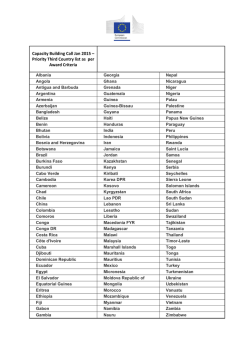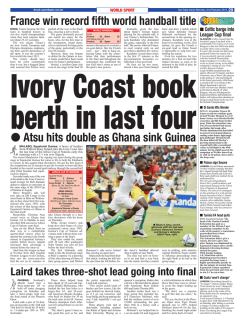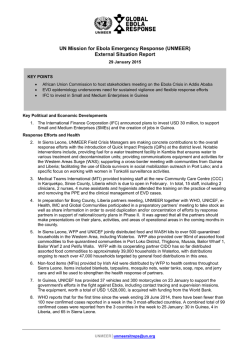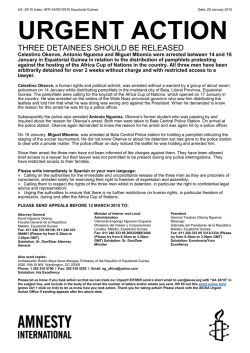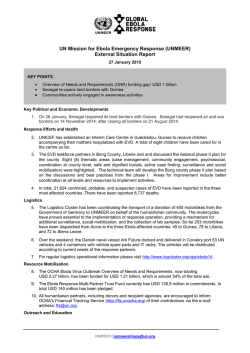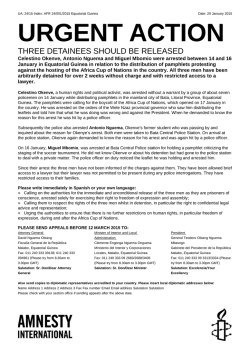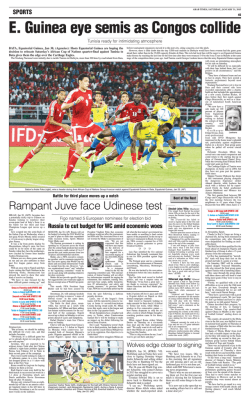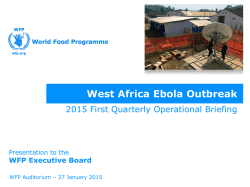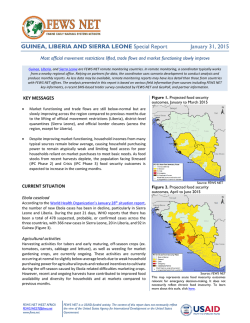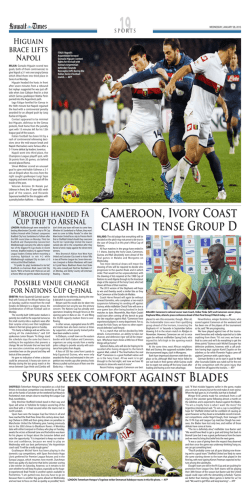
Download PDF (851.84 KB)
ACAPS - Country profile: Guinea 29 January 2015 Guinea: Country Profile Guinea covers an area of 245,857km2, and borders Guinea-Bissau, Senegal and Mali in the north, Côte d’Ivoire in the east and Liberia and Sierra Leone in the south. 320km of coastline in the southwest faces the Atlantic Ocean, where the capital Conakry is located. Summary Indicators Indicator Value Year Population number (last census) 10 628 972 2014 (preliminary) Population growth rate % 2.63 2014 (est.) Population density 43/km2 2014 (est.) Urban composition % 35.4 2011 Average household size 7 2014 (est.) Net migration rate 0/1000 2014 (est.) Age distribution (% under 15) 42 2014 (est.) Life expectancy at birth (years) 59.6 2014 (est.) <5 mortality per 1,000 live births 101 2012 Maternal mortality per 100,000 live births Underweight (moderate and severe) % under 5 Chronic malnutrition (moderate and severe) % under 5 Acute malnutrition (moderate and severe) % under 5 650 2013 18.7 2012 31.3 2012 9.9 2012 HDI ranking and value Corruption perceptions index ranking (value) 179 (0.392) 2013 145 (25) 2014 People below the poverty line % 47 2006 (est.) Hunger index ranking (value) 44 (16.6) 2012 World Risk Index ranking (value) 48 (8.53) 2014 Literacy rate % (male/female) 41 (52/30) 2010 (est.) Sources: CIA Factbook, IFPRI 2012, Transparency International 2014, UNDP 2014, UNICEF 2013, UNU 2014, WHO, WHO, WHO 2014 Administratively, the country is divided into seven regions – Boke, Kindia, Labe, Mamou, Faranah, Kankan and Nzerekore – and one special administrative zone, Conakry, which consists of the greater urban area of the capital. The regions are subdivided into 33 prefectures, which are further divided into communes or subprefectures (303 rural and 38 urban communes, five of which make up the city of Conakry). Geographically, Guinea can be divided into four regions – Maritime Guinea, MidGuinea, Upper Guinea and Forest Guinea (Institut Nationale de la Statistique (INS), CIA Factbook). Society and Communities Ethnic or tribal groups: The Peul (Fulani) are the largest ethnic group, making up 40% of Guinea’s population. The Malinke comprise 30%, and the Soussou 20%. The remainder consists of different communities inhabiting the Forest region. Guinea’s four geographical regions largely correspond to the main ethno-linguistic groups. The Peul mainly inhabit the Fouta Djallon mountain plateau in Mid-Guinea. The Malinke are concentrated in Upper Guinea, in the Niger plains. The Soussou are the dominant population along the coast in Maritime Guinea, including in Conakry. There is no dominant group in Forest Guinea, the forested highlands in the southeast, which are inhabited by numerous minority groups who originally moved there to escape Malinke domination. The strong sense of identity among Guinea’s ethnic groups has turned into increasing ethnic tensions since elections in 2010 (Minority Rights Group International; IRIN, 11/12/2011; CGRA OFPRA and ODM, 03/2012). The official language in Guinea is French. Fulani and Mande are widely spoken, as well as languages of other ethnic groups (CIA Factbook). Religion: Islam is the main religion in all four geographic regions, covering 85% of the population, and is the dominant religion among Peul and Malinke. Muslims are generally Sunni, but the number of Shi’a is increasing. 10% are Christian and 5% follow traditional beliefs, which are most prevalent in the Forest region. Freedom of religion is constitutional, and the various religious groups maintain good relations. Some Christians and Muslims incorporate traditional beliefs and rituals into their religious practices (US Department of State, 17/11/2010; CGRA OFPRA and ODM, 03/2012). 1 ACAPS - Country profile: Guinea Gender equality: Vast gender differences prevail, despite the principles of gender equality and non-discrimination being constitutional. Early and forced marriages still exist, particularly in rural areas. 37.9% of girls aged 15-19 were married, divorced or widowed in 2005, and 63% of women aged 20-24 were married before the age of 18. Women have the right to divorce, but custody of children over 7 and the majority of communal assets are generally awarded to men. Customary practice inhibits women from inheriting land. Women have difficulty accessing bank loans, although legally they have equal rights to financial services. Violence towards women and girls is a long existing phenomenon. 92% of women aged 15-64 have been the victim of at least one act of violence. Women are underrepresented in the non-agricultural sector, where they make up 18% of the labour force (2012). 74% of women decide themselves how to use the money they earn (2012). In 2011, the female:male ratio in primary schools was 83 girls for every 100 boys, and 57 girls for every 100 boys in secondary schools (Government, 02/2013; Gender Index; World Bank; DHS, 2012; INS, 2012). Education: Primary school covers ages 7-12, and secondary school 13-19. An estimated 57% of 7-12 years olds are enrolled in schools. Major discrepancies exist between rural and urban areas: enrolment is 82% in urban areas and 48% in rural. Conakry (85%) and Mamou (65%) are the only regions with enrolment above the national average. Literacy is estimated at 34% among people of 15 and above, but varies greatly according to area of residence. The literacy rate is 20% in rural areas and 59% in urban areas. Conakry stands out with 65% of its adult population being literate, followed by Labe at only 35%. There are large gender differences, with 47% compared to 23% literacy for male and female populations, respectively (INS, 2012). In 2012, an estimated 38% of heads of household had no formal education and almost 50% of children aged 6-14 had never been to school (WFP, 01/2014). Child protection: 48% of children aged 5-14 are involved in child labour. Child labour is most common in the regions of Labe (63%), Faranah (62%) and Nzerekore (62%), and least common in Conakry (22%) (Guinea Demographic and Health Survey (DHS), 2012). Historical Background Independence: In 1958, Guinea was the only French colony to opt for immediate independence from France. France reacted by interrupting all support to Conakry. The founding president, Sekou Toure, established a one-party dictatorship and turned to the Soviet Union to reinforce his rule. In an attempt to modernise society, traditional forms of cultural expression were suppressed, often violently. This policy mostly affected Forest Guinea and significantly contributed to a major divide between this region and Conakry. Alleged or actual attempts to overthrow the regime led to increasingly brutal repression and an extensive system of detention. An especially violent period followed the events of 1970, when a group of Portuguese military officers, colonial troops from Guinea-Bissau, and Guinean exiles were involved in an attempted coup. The violent repression in the following years targeted Guineans in general, but since ethnic tensions have increased more recently, the Peul have been emphasized as a particular target during that period (BTI, 2014; Arieff and McGovern, 2013). Military Junta: A military coup led by Lansana Conte followed the death of Toure in 1984. Reforms towards a market economy were adopted and benefited the mining sector. Political governance remained dominated by repression, corruption and rigged elections. The economy deteriorated quickly in the 2000s as the administration weakened. Since the 1990s, Guinea has been affected by civil wars in neighbouring countries, Liberia, Sierra Leone, and later Côte d’Ivoire. Conakry provided support to opponents of the Liberian Charles Taylor and financed certain armed groups. The Forest region especially was implicated in the conflicts, as it served as a hub for arms and combatants. The hosting of armed groups in the region contributed to a deterioration of the local political climate and increased tensions between communities. In 2000, Guinea faced a series of armed attacks from several fronts in Liberia and Sierra Leone. Insecurity and tension in the Forest region was exacerbated in October 2000 by the massacre of several intellectual Foresters, who were killed in Conakry as they denounced the presence of paramilitary forces in the region (BTI, 2014; Arieff and McGovern, 2013; International Crisis Group (ICG), 19/12/2003; Carter Center, 2010). First free elections: Following Conte’s death in 2008, a new military junta came to power. Despite promises to restore democracy, public discontent continued. The military regime ceded power after the escalation of popular protests in 2009 and a brutal repression of demonstrations led by civil society. A transitional government was appointed and elections were held in 2010. Current president Alpha Conde won the first free presidential elections in 2010. Since then, crucial reforms have been implemented to control the state’s budget. Expenditure in the security sector has been reduced and a more rigorous mining code adopted. The population, however, has benefited little from these reforms. Standards of living have diminished steadily since the beginning of the century (BTI, 2014, Carter Center, 2010). Ethnic tensions: Historically, relations between different ethnicities have been good. In 2010, the election played a major role in fuelling ethnic tensions on a national scale, as ethnic identities were used to mobilise political constituencies. Perceived favouritism of the president’s ethnic group, the Malinke, polarised the 2 ACAPS - Country profile: Guinea political climate. The Peul, the opposition, felt excluded. These tensions are mostly visible in politics, rather than in society. In the Forest region tensions exist between minorities and those who held power in Conakry, mainly Peul and Malinke. Attempts to undermine the Foresters’ traditional religious beliefs have fuelled distrust and resistance towards the national authorities (CGRA OFPRA and ODM, 03/2012; Anoko, 2014). Upcoming elections: Municipal elections were originally scheduled for 2014, but have been postponed indefinitely, supposedly due to the Ebola outbreak. New presidential elections are due in 2015, but the opposition is sceptical and accuses the Government of using Ebola as an excuse to delay the elections. Controversy over the elections is fuelling ethnic divides (ICG, 15/12/2014; Voice of America, 15/10/2014). Political Stakeholders and Background Governance Political parties: Guinea has a multi-party system, with more than 120 registered parties. However, eight parties dominate national politics. The Rally of the People of Guinea (RPG) is the current ruling party under President Alpha Conde, whose stronghold is in Upper Guinea, where he enjoys the support of his ethnic group (Malinke). Conde was a popular figure as a historical opponent of President Conte. The largest opposition party is the Union of Democratic Forces (UFDG). The UFDG has its main support in Mid-Guinea, where the ethnic group of its leader (Peul) is dominant (Carter Center, 2010; EU, 02/2011). Legal system: The judicial system is based on French civil law, in addition to customary law and decree. The system is composed of courts of first instance, two Courts of Appeal, in Kankan and Conakry, and the Supreme Court. The State Security Court, a military tribunal, handles charges against accused military personnel. Members of the State Security Court are directly appointed by the president. A traditional system of dispute resolution exists at the local level, and cases may be referred to the courts if not resolved here. Historically, the judiciary has been subject to the executive. Judges are reluctant to contradict executive authority, undermining the judiciary’s independence and its legitimacy. Consequently Guineans have little faith in judicial institutions. The current Government has shown ambition to improve transparency and good governance, without making any concrete changes. A lack of resources and capacity limits the ability of courts to handle cases in a timely manner and prisons are overcrowded Presidential elections: During the last presidential elections in 2010, the main contenders were associated with their respective ethnic communities. In the first round, Cellou Dalein Diallo (UFDG) got 44% of the votes and Conde (RPG) 18%. Though the candidates eventually accepted the results, the announcement was followed by a period of protests, in which both parties politicised ethnic sentiment. The second round was preceded by ethnic violence. Conde won a majority of 52.5%, which was contested by Diallo and his supporters, and sparked more protests and riots. A state of emergency was declared to control the street violence. Calm returned after the Supreme Court confirmed the results. The elections left behind an ethnically polarised political climate (EU, 02/2011; Le Monde, 15/11/2010; BBC, 15/11/2010; Carter Center, 2010; IRIN, 06/12/2011). Legislative elections: Legislative elections should have been held within six months of the 2010 presidential elections. They were delayed for more than two years and finally held in 2013. The delay undermined the Conde administration’s credibility, as many Guineans saw this as an attempt to tilt the conditions in the presidential party’s favour. These elections were also accompanied by political and ethnic violence. No single party reached a majority in the National Assembly. The RPG took 53 of 114 seats, and formed a coalition with six other parties to reach a majority of 59. The UFDG remained the largest opposition party, with 37 seats. Results were again contested by the opposition, alleging fraud, but validated by the Supreme Court (Le Monde, 28/09/2013; Le Figaro, 21/10/2013; BTI, 2014; BBC, 16/12/2013). (BTI, 2014; DCAF, 2011; US Department of State, 2003). Traditional justice system: At the village or urban neighbourhood level, cases can be presented to village chiefs, neighbourhood leaders, or a council of ‘wise men’. This system is preferred by many due to judiciary corruption, though the divide between the two systems is not clear. Cases may be referred from the traditional to the formal justice system and the other way around, for example, to ensure compliance (US Department of State, 2003; UNPAN, 2004). Local councils: Government administration is carried out at regional level. A governor, appointed by presidential decree, heads each of the eight regions. The highest governing and executive local authorities are urban communal councils, led by a mayor and deputies, and rural community councils, led by a chairman, vicechairman and treasurer. Executives of the local councils are appointed by the freely elected members of the council. They oversee local development, elections, implementation of the budget and management of public services, such as education and health. Income comes from various taxes and revenues, and occasionally from grants or loans. Guinea has legislated gender quotas to assure 33% of the members of local councils are women (UNCDF, 2008; UCLG, 2006). 3 ACAPS - Country profile: Guinea Decentralisation: Guinea’s governance has historically been highly centralised, following the French colonial administration and the subsequent socialist authoritarian governments. Even after decentralisation was declared as a state vision in 1985, it did not have a serious legal basis until 2006. Power was brought to local government for the first time in 2005. The military junta that came to power in 2008, and the current Conde Government have continued the decentralisation process (Picard and Moudoud, 2010; World Bank, 28/09/2008). Security forces: Throughout different regimes, the security and defence forces have been used by the Government to violently suppress political opposition and have been involved in many cases of human rights violations. Historically, the president had authority over security sector governance and the armed forces were highly politicised. The current president is still responsible for national defence and is the commander of the armed forces, appointing all high-ranking military. Parliamentary oversight of the security sector is minimal, although security sector reforms have taken place and security forces are now more professional than during the junta period. Nonetheless, they continue to extort money from citizens at border crossings and roadblocks (DCAF, 2011; DCAF, 2011; BTI, 2014). Military system: The national army was established in 1958 with volunteers from the colonial army. During the Toure regime the military was deprived of resources, training and equipment, and poorly organised. After 1984 the military expanded under the junta. In 2005 it consisted of 14,000 men, comprising the army, air forces, navy and gendarmerie. The army represented the largest component, with 9,700 men. Defence and security cooperation with international partners has intensified since 2000. The military has taken part in several international peacekeeping operations, such as in Haiti and the Democratic Republic of Congo. Under the current Government, 4,000 soldiers have been retired (DCAF, 2011; DCAF, 2011; BTI, 2014). Corruption: In 2014 Guinea ranked 145 out of 175 in the corruption perceptions index, with a score of 25/100. In 2006 Guinea was considered the fourth most corrupt country in the world. Some improvements have been made, with more transparent public expenditure and revenues. The new mining code aims to make all mining contracts public. Nevertheless, corruption is still widespread (Transparency International, 2014; BTI, 2014; IRIN, 24/09/2008). Economy Despite great mineral deposits, agricultural resources, hydropower and solar power, Guinea has not been able to profit from its potential. Guinea’s GDP grew annually by 2.97%, on average, between 2004 and 2013. This growth is believed to be largely attributable to revenues from the mining sector. Private consumption per capita decreased over the same period. The largest threats to the economy include political instability and low international commodity prices. GDP growth was expected to be 4.2% in 2014 (World Bank, 2014; CIA Factbook; Année Stratégique 2015; Afican Development Bank, 2014). Budget: In 2013, taxes and other revenues made up 23% of GDP. Annual revenues totalled USD 1.508 billion, and expenditures USD 1.839 billion in 2013, leading to a budget deficit of 5.1% of GDP. In 2012, public debt augmented to 35.4% of GDP (CIA Factbook; Année Stratégique 2015). International assistance and investment: After several reforms, Guinea reached the completion status for the Heavily Indebted Poor Countries initiative in 2012, allowing the country to erase USD 2.1 billion of its debt. International donors halted their development programmes after the 2008 coup, but resumed them with the transition of 2010. Private investments averaged 15% of GDP between 2007 and 2012, mainly in the mining sector (World Bank, 2014; France Diplomatie, 2014; CIA Factbook). In 2011, foreign direct investment accounted for 18.79% of GDP, official development aid for 4.49%, and remittances 1.27% (UNDP, 2011). Currency: The national currency is the Guinea Franc (FG). One US dollar equals approximately 6,780 FG (Currency Converter, 15/01/2015). Gross National Income per capita: USD 520 (UN Statistics Division, 2012). Inflation rate: 11.9% (World Bank, 2013). Remittances: 93 million USD were received in remittances in 2013, about 1.5% of GDP (World Bank, 2013). Employment: 66% of people over 15 years old are employed. 76% of the labour force is employed in the agricultural sector, 24% in industry and services. 69% of the population are economically active, including 77% for rural and 56% for urban areas. This difference can be attributed to the levels of education in rural and urban populations. The remaining 31% is reportedly economically inactive, which may include agricultural workers who have seasonal periods of inactivity. The difference in economic activity between the male and female population is relatively small, at 71% and 68%, respectively (INS, 2012; CIA Factbook, 2006). Agriculture: The agricultural sector accounts for about 20% of GDP (2013). The main agricultural products include rice, coffee, palm kernels and cassava. Production is for export and for local consumption (CIA Factbook; World Bank, 2013). Services: Services accounted for 42% of GDP in 2013 (World Bank, 2013). 4 ACAPS - Country profile: Guinea Industry: Industry accounted for 38% of GDP in 2013 (World Bank, 2013). Key industries: Guinea’s economic growth has become increasingly dependent on resource extraction. Key industries include bauxite, gold, diamonds, iron ore, alumina refining, light manufacturing and agricultural processing (CIA Factbook, 2012). Extractive sectors: Until 1990, mining accounted for more than 20% of GDP, but mismanagement and political uncertainties led to a drop in its contribution. In recent years reforms in the sector have led to increased foreign investment and higher revenues. In 2011 mining accounted for more than 25% of GDP and 95% of exports. Guinea is the second largest exporter of bauxite, and is thought to have the largest bauxite reserves in the world. Small-scale gold mining is a traditional activity, and several formal and informal mines together export around 20 metric tons of gold yearly. Large iron ore deposits are also being exploited (EITI, 2012; Natural Resource Governance Institute). Main export products: Bauxite, alumina, gold, diamonds, coffee, fish, agricultural products. (CIA Factbook, 2012). Main partners (exports): India (10.6%), Spain (9.6%), Chile (9.4%), US (7.1%), Ireland (6.3%), Germany (6.3%), Ukraine (5.7%), France (5%) (CIA Factbook, 2012). Main partners (imports): China (14.2%), Netherlands (7.6%) (CIA Factbook, 2012). Food imports: Guinea has historically been an exporter of agricultural products, but is now importing the majority of foodstuffs. In 2011, 20% of total imports were foodstuffs (CIA Factbook; FAO, 2011). Infrastructure Airport: 16 airports, four of which have paved runways. The international airport is located in Conakry and domestic airports can be found near the regional capitals of Boke, Faranah, and Kankan (CIA Factbook; Logistics Cluster, 22/01/2011). Road network: Total road network of 44,348km, 10% of which is paved (4,342km). Primary roads connect Conakry to cities inland, such as the regional capitals. Major roads connect the country to other major cities in the region like Bamako in the northeast, and Freetown, Monrovia, and others in countries to the south. The northern and eastern areas, along the borders with Senegal, Mali and Côte d’Ivoire, are less well connected (CIA Factbook; Logistics Cluster, 22/01/2011). The logistics cluster produced a map of the road network (Logistics Cluster, 31/05/2013). Railways: Total of 1,185km of railway. The main function of the network is to transport mining products and connect Conakry to inland cities like Kindia, Mamou and Kankan. Another railway connects Conakry and its port to the bauxite mine in Fria, in the maritime area. A third in the north connects the port of Kamsar to Boke and the bauxite mine in Sangaredi (CIA Factbook; Logistics Cluster, 22/01/2011). Ports: There are major seaports in Conakry and Kamsar, near the border with Guinea-Bissau (CIA factbook). Electricity: In 2010, 20% of the total population had access to electricity. This includes 53% of the urban population, but only 3% of the rural population (World Bank, 2010). Access to electricity is highest in Conakry, where electricity is reported as the main source of light in 70% of households, compared to 0.2%-16% in the other regions (INS, 2012). Poverty In 2012 poor and very poor households represented 57% of the national population. This proportion has remained fairly stable. Factors that contribute to the high prevalence of poverty include political and institutional instability, poor economic governance, unconventional tax exemptions and significant military expenses. The global financial crisis affected Guinea in terms of loss of remittances and large price increases for imported products, such as petrol and foodstuffs (WFP, 01/2014; Government, 2011). Poverty disproportionately affects small rural households run by illiterate or uneducated older women (WFP, 01/2014). Correlation to other variables or contextual elements: A low level of education is one of the root causes for Guinea’s endemic poverty, which therefore affects households in rural zones more than in urban zones. External shocks such as floods, affecting 50,000-69,000 people annually, diseases and shocks to agriculture, further contribute to the spiral of poverty, as poor households are often unable to respond to these (WFP, 01/2014). Great disparities exist between rural and urban areas in terms of wealth and access to basic services. Conakry stands out as having comparatively higher standards of living (INS, 2012). Food security: A baseline study conducted in June-July 2012 showed that there are pockets of severe food insecurity in Guinea, especially in the Forest Guinea region and Faranah prefecture. Moderate food insecurity remains important, especially in the lean season (July-September), as this may evolve for a large portion of the population that is highly vulnerable and experiences food-related stress. Between 2009-2012, severe food insecurity decreased but moderate food insecurity increased. The total number of households vulnerable to food insecurity was about one third of the population in 2012. Food insecurity primarily affects the poorest households. It is caused by limited financial and physical access to food, 5 ACAPS - Country profile: Guinea and poor management of revenues and food stocks rather than by lack of availability. Community isolation is one of the most significant factors in determining food security. 41% of rural and 31% of urban households are affected by food insecurity (WFP, 01/2014). Prevalence of food insecurity is highest in the west (particularly Boke, Kindia and Conakry regions), and in the south (notably in Nzerekore region). In these regions the demand is greater than the supply, resulting in higher prices than in the rest of the country. Market exchanges are unfavourable for producers, which is exacerbated by the proximity of cross-border markets (WFP, 01/2014). On average, households spend 78.5% of their expenditure on foodstuffs. Food expenditure at household level is 83.1% for lowest quintile, and 73.3% for highest quintile (INS, 2012; DHS, 2012). Livelihoods: Agriculture and pastoralism are the primary livelihoods for 97% of the rural population. About 50% of agricultural and pastoralist households face limited revenue and production flow difficulties (WFP, 01/2014). The Forest region is the most important agricultural zone in the country. Guinean farmers tend to use their own seeds from the previous year’s harvest. The use of commercial pesticides, fertilisers or herbicides is limited (FAO and WFP, 17/12/2014). Livestock is ranked second among livelihoods of the population of Guinea. Besides an important transhumance from the higher parts of Fouta Djallon to the coast, there is cross-border transhumance to Mali, Cote d’Ivoire and Guinea-Bissau (FAO and WFP, 17/12/2014). Health For more information, please see our Briefing Note of the impact of the Ebola outbreak on Health Health system: The public health system has a pyramidal organisation. The Ministry of Health and Public Hygiene operates at three administrative levels: the central national level, the intermediary level, including the eight administrative regions, and the periphery, the most decentralised operational entity of the health system represented by 38 health prefectures. Two national reference hospitals are located in Conakry. The other seven regions have their own hospitals, which serve as reference clinics for the respective regions. Community medical centres and health posts are spread throughout the country, constituting 96% of all health structures in the interior of Guinea. A general problem of the system is a lack of financial resources and personnel (CGRA OFPRA and ODM, 03/2012; OSAR, 14/10/2010; INS, 2012). In 2012 Guinea had 871 registered doctors, corresponding to 1 doctor for almost 13,000 people. Conakry has the most doctors per head of population, with one doctor per 4,500 people. In the rest of the country the ratio is between one doctor per 13,300 people (Kindia) and one per 29,500 (Nzerekore). The nurse to population ratio varies from 1 in 3,600 in Conakry to 1 in 24,400 in Kankan, and midwife to population ratio is 1 in 1,500 in Conakry and reaches up to 1 in 29,000 in Kankan (Government, 2012). The private health sector is essentially situated in Conakry, where it represents close to 90% of all existing health structures. At the national level, private structures make up 20% of the total. Prices of care in the private sector are much higher, but the quality remains below standard in many of the clinics (OSAR, 14/10/2010). The purchase of pharmaceuticals is centrally organised by the Central Pharmacy of Guinea (PCG), which has regional centres in Labe, Faranah and Nzerekore. This system limits access to essential medication, as distribution often encounters difficulties, leading to shortages that can last several months (CGRA OFPRA and ODM, 03/2012; OFAR, 14/10/2010). Health expenditures: In 2011, the Government devoted 6% of the national GDP to health, comparable to the years in the preceding decade (UNDP, 2011). However, between 2004 and 2007, only half of the allocated budget was actually spent on health. Foreign aid represents an important part in the financing of the health sector. In 2012, foreign aid accounted for 27% of health expenditure in Guinea, making it the second largest source of health sector finance (OSAR, 14/10/2010; WHO, 05/2013). In 2007, the Government contributed 11% to the total expenditure on health in Guinea. Close to 100% of private expenditure on health was out-of-pocket (WHO, 2010). At the household level, health represents on average 3.4% of total expenditure (DHS, 2012). Health information system: The Department of Health Statistics and Information (SSIS) of the Office of Strategy and Development (BSD) is responsible for the collection of national health surveillance information, which include monthly and trimestral reports from the regional and the prefectural level (Government, 2012). Vaccination: Vaccination coverage in the country is very low. In 2012 only 37% of children between 12-23 months received all recommended vaccinations, and 11% did not receive any vaccination, which represents a deterioration compared to 2005 (14%). Of children 12-23 months 82% received a BCG, 47% DTP and 49% polio vaccinations. 31% were vaccinated for yellow fever. Measles vaccination coverage is 62%, and half of vaccinated children received the vaccine before 12 months of age. Vaccination coverage in urban environments is considerably higher than in rural areas, demonstrated by measles vaccination coverage which is 75% in urban and 57% in rural areas. For virtually all vaccinations coverage is highest in Conakry. Vaccination coverage is also related to income levels, as coverage is highest among the richest quintile and lowest among the poorest (DHS, 2012). Female genital mutilation (FGM): The topic is still taboo in certain communities, which makes it difficult to obtain reliable data. In 2012, 97% of women aged 15-49 had experienced FGM, a proportion that has been more or less stable since 1999. 6 ACAPS - Country profile: Guinea The proportion of women who have undergone FGM is lower somewhat in younger generations. FGM remains a common practice in Guinea and occurs across all ethnicities and religions. It occurs less among Christians, with 78% of adult women, compared to virtually all Muslim women. The Guerze is the only ethnic group with a substantially lower FGM rate (66%) (DHS, 2012). Main contributors to mortality and morbidity: Communicable diseases are the main cause for the majority of years of life lost (71%). Among children under 5, most deaths are attributable to malaria (27%), followed by respiratory infections (13%), birth asphyxia (12%), prematurity (11%) and diarrhoea (8%). Under 5 mortality rates are much higher in rural areas (148 per 1,000 live births) than in urban areas (87 per 1,000 live births) (DHS, 2012; WHO, 2014). Malaria: Malaria is endemic in Guinea, transmitted by the Plasmodium falciparum parasite. Since 2010, people of all ages have free access to malaria medication in the public sector. Among all age groups, malaria represents 34% of consultations, 31% of hospitalizations and 14% of deaths, which makes it one of the main public health problems. Among children between 6-59 months, malaria prevalence is 44%. The highest prevalence is found in Faranah (66%), Nzerekore (59%) and Kindia (55%) (WHO, 2014; DHS, 2012). Cholera: Cholera is a recurrent disease, with the most recent outbreak in February 2012. Densely populated urban slums, with minimal access to services, were worst affected. Neighbouring Sierra Leone was also hit by the outbreak. The epidemic worsened in July and August, reaching 5,699 cases and 109 deaths by 2 September 2012. 11 of 33 prefectures were affected. International assistance was required to contain the cholera outbreak (IRIN, 24/09/2012; IFRC, 11/03/2013). Tuberculosis (TB) and HIV: 1.7% of the adult population is infected with HIV, leaving an estimated 130,000 people living with HIV in Guinea. Only 50% of those eligible to antiretroviral therapy are being treated. TB prevalence is 244 per 100,000 people, and 28% of cases are multi-drug resistant. This is further complicated by a high number of HIV and TB co-infections (WHO, 2014; WHO, 2014; Interagency Task Team, 20/10/2014). Nutrition: Guinea has high chronic malnutrition rates, which can be explained by insufficient care practices, limited access to health care, and a lack of food diversity and heavy reliance on grains. Chronic malnutrition is twice as high in rural as in urban areas: 36% and 18%, respectively. A discrepancy is clear between Conakry and other administrative regions. 15% of children under 5 in Conakry are chronically malnourished, compared to 41% in Mamou and 38% in Nzerekore, the regions with the highest prevalence. In addition, global acute malnutrition levels exceeded the emergency threshold of 10% in the mining zones of Upper Guinea (WFP, 01/2014; DHS, WASH Water supply: Nationally 75% of households have access to improved drinking water sources, most of them (39%) being wells with pumps or boreholes. 10% use surface water as a main source of drinking water. Access to safe drinking water shows disparities between urban and rural households. 96% of urban households use an improved drinking water source, which comes from a tap in more than half of the households. In rural areas, only 65% has access to an improved water source, and 51% uses boreholes. In Conakry, almost all households are using improved sources (99%). The lowest coverage is in Kindia and Mamou (both 56%). In these regions, respectively 28% and 19% of households use surface water as their source of drinking water. In rural households, only 10% have a water source on premises, and 40% spend more than 30 minutes fetching water, compared to 18% for urban households (DHS, 2012). Sanitation: About one in five households have access to improved, non-shared toilet facilities, and one in four use shared hygienic toilets. 56% of households use non-improved toilet facilities. 29% of rural households do not have access to any kind of toilet facility. Faranah (77%) and Mamou (71%) have the highest proportion of unimproved toilet facilities, and Conakry the lowest (8.7%). Open defecation is most common in Labe (48%), Mamou (33%) and Nzerekore (33%) (DHS, 2012). Waste management: There is no well-established system for solid waste management. 70% of households dispose of their waste in nature. In urban areas, this proportion is lower (47.1%) than in rural areas (80.2%). Conakry is the only region with an apparent waste collection system, either via use of private or public waste bins or via truck collection. Incinerators are another common way of handling solid waste (INS, 2012). Floods: Guinea experiences floods almost yearly during the rainy season (MayOctober). The last floods happened in August 2011, following heavy rainfall, and mainly affected the prefectures of Labe and Siguiri and areas of Conakry. At least 1,920 houses were damaged or destroyed, as well as 542 latrines and 212 wells, which had become unusable. After the floods political violence erupted, as the opposition protested against the government’s unilateral decision to hold legislative elections in December 2011. As a result, some of the relief operations were delayed (IFRC, 29/11/2011). 2012). 7 ACAPS - Country profile: Guinea Media and Communication Ownership: Guinea has one state owned news agency, Guinean Press Agency. The state runs one TV station. The state owned radio station also operates a number of stations in rural areas. The number of privately owned and community radio stations are increasing, especially in Conakry (CIA Factbook). TV: Possession of a TV is much more common among urban households, where coverage is 68% of households compared to only 5% of rural households (DHS, 2012). Radio: 62% of households possess a radio. This varies from 72% in urban to 56% in rural areas (DHS, 2012). Newsprint: There are over 250 active print outlets (IREX, 2008). Mobile phone utilisation: Guinea had 7.4 million mobile cellular subscriptions in 2013, corresponding to 63.3% of the population (World Bank, 2013). Internet utilisation: The use of internet is not widespread, only 1.6% of the population has access (World Bank, 2013). Foreign Relations Regional organisations: Guinea is seeking to improve its integration in the region and is a member of the Niger Basin Authority, which aims for more integrated and sustainable development across the member countries, and the Mano River Union, which includes Sierra Leone, Liberia and Cote d’Ivoire. Guinea has been involved with these three neighbouring countries during their civil wars, not only at the political level, but also by hosting several hundreds of thousands of refugees and participating in the UN West African peacekeeping mission (ECOMOG). The end of the war in Liberia permitted reconciliation between the Mano River Union Members. Guinea is a member of ECOWAS, which played an important role in resolving the regional tensions during the civil wars. After the election of President Conde, the African Union lifted the sanctions it had imposed on the country (France Diplomatie, 26/09/2014; ECOWAS, 2000; BBC, 11/02/1998). European Union: After the 2013 elections the EU resumed cooperation with Guinea, under the European Development Fund. It had been suspended since the military coup in 2008. The EU is an important donor for Guinea, having released EUR 140 million in 2014, to support the promotion of good governance and human rights, and to improve the road infrastructure. Other financial aid has been directed towards improving access to social services and supporting the transition to democracy. The EU is an important trading partner, for both exports and imports. Since 1976, Guinea has had a military cooperation mission with France, which has been involved in projects to support schools, logistics, gendarmerie and military health (EU external action; CIA Factbook; DCAF, 2011). China: China is an important investor in Guinea, notably in the mining sector. When in 2009 many international donors and investors pulled out of the country after the military junta’s Stadium Massacre, China was negotiating an enormous mining and petrol contract of more than USD 7 billion (Le Figaro, 14/10/2009). United States: The US played a key role in the political transition in 2010 from the military junta to free presidential elections, which they supported with diplomatic and financial means. Aid to Guinea is focused on security sector reforms, health system strengthening and socioeconomic development (Congressional Research Service, 16/10/2014). Humanitarian and Development Stakeholders A large variety of national and international humanitarian actors have attempted to meet protection and other assistance needs over the years. Humanitarian aid has mainly taken place without a well-developed national legal framework or strong national structures that can deliver basic services. Since the civil wars in neighbouring countries and the large influx of refugees into Guinea several actors, including UNHCR, were present to meet the refugees’ needs. (ALNAP, 2004; HPN, 31/09/2005). Guinea has not been a consistent recipient of aid. Due to its long lasting political crisis donors have often pulled out. The lack of information about the scale and nature of needs in Guinea results in low levels of funding. Development aid dropped significantly with the involvement of the country in the regional civil wars, but increased after the influx of refugees in 2000. As the political climate deteriorated, development and humanitarian aid decreased further until after the military coup in 2008. Major bilateral donors that suspended their aid following the coup include the United States, European Commission and France. Between 1995 and 2008, 70% of ODA came from the five main bilateral donors and the World Bank. This share dropped to 55% after 2008. The total number of donors in 2008 was 38, many of whom gave relatively small amounts (Global Humanitarian Assistance, 08/09/2010). Perceptions: Issues with past international interventions have fuelled distrust of the international community. In the 1990s, the government feared incursion into domestic politics by humanitarian actors that had been leading refugee programmes, and limited the organisations’ statutes. At the same time, the host 8 ACAPS - Country profile: Guinea population often viewed NGO and UN-agencies’ actions as lacking safeguarding for their own communities. This has resulted in a strategy of self-defence against external actors. These do not only include international organisations, but also government representatives (Cultural Anthropology, 07/10/2014; HPN, 31/09/2005). HPN (31/09/2005) Towards a new model for post-emergency refugee assistance IFRC (29/11/2011) Floods – DREF operation no MDRGN004 Update no 1 IFRC (11/03/2013) Guinea : Cholera DREF operation no MDRGN005 Final report Institut Nationale de la Statistique (INS) (2012) Annuaire Statistique 2012 Key Documents ALNAP (2004) The case of Guinea Anoko (2014) Communication with rebellious communities during an outbreak of Ebola Virus Disease in Guinea: an anthropological approach Arieff and McGovern (2013) “History is stubborn”: Talk about Truth, Justice, and National Reconciliation in the Republic of Guinea, Comparative Studies in Society and History 04/01/2013 BBC (11/02/1998) ECOMOG: peacekeeper or participant? BBC (15/01/2015) Guinea profile BBC (15/11/2010) Alpha Conde declared winner in Guinea president polls BBC (16/12/2013) Guinea’s Supreme Court upholds election result BTI (2014) Guinea Country Report Carter Center (2010) Observing the 2010 Presidential Elections in Guinea CGRA, OFPRA and ODM (03/2012) Rapport de Mission en République de Guinée INS (2012) Enquête légère pour l’évaluation de la pauvreté International Crisis Group (ICG) (19/12/2003) Guinée: incertitudes autour d’une fin de règne ICG (15/12/2014) Guinea’s Other emergency: Organising Elections Interagency Task Team (20/10/2014) Ebola Crisis – Ensuring continuity of HIV services IRIN (06/12/2011) Guinea: Avoiding ethnically-driven elections IRIN (11/12/2011) Guinée: Les divisions ethniques menacent le bon déroulement des élections IRIN (24/09/2008) Guinea: Reputation for corruption worsens IRIN (24/09/2012) Cholera outbreak easing Le Figaro (14/10/2009) La Chine déverse ses milliards sur la Guinée Le Figaro (21/10/2013) L’opposition guinéenne conteste les élections Le Monde (15/11/2010) Guinée : Condé déclaré vainqueur de l’élection présidentielle Le Monde (28/09/2013) Législatives sous tension en Guinée après des années de chaos Multiple Agencies (2012) Guinea Demographic and Health Survey (DHS) Congressional Research Service (16/10/2014) Guinea: In brief Picard and Moudoud (2010) The 2008 Guinea Conakry coup: Neither inevitable nor inexorable Journal of Contemporary African Studies 04/02/2010 Cultural Anthropology (07/10/2014) Ebola in Guinea: Revealing the State of the State UCLG (2006) Country Profile Republic of Guinea DCAF (2011) Parliamentary Oversight of the Security Sector: ECOWAS Parliament-DCAF Guide for West African Parliamentarians UNCDF (2008) Programme de Développement Local en Guinée (PDLG II) DCAF (2011) Security Sector Governance in Francophone West Africa: Realities and Opportunities UNPAN (2004) Republic of Guinea Public Administration Country Profile US Department of State (17/11/2010) International Religious Freedom Report 2010 DCAF (2011) The Security Sector and Gender in West Africa: A survey of police, defence, justice and penal services in ECOWAS states US Department of State (2003) Country Reports on Human Rights Practices ECOWAS (2000) Executive Secretary’s Report Voice of America (15/10/2014) Guinea Opposition Cries Fould to Ebola-Related Election Delay European Union (EU) (02/2011) Rapport Final: Mission d’observation électorale en République de Guinée – Election Présidentielle de 2010 WFP (01/2014) Engête Nationale de la Sécurité Alimentaire et de la Vulnérabilité FAO and WFP (17/12/2014) Guinea – FAO/WFP Crop and Food Security Assessment, December 2014 WHO (2010) Guinea – Factsheets of Health Statistics 2010 Global Humanitarian Assistance (08/09/2010) Aiding Guinea: Time for a promotion from limbo WHO (2012) Guinea: health profile Government (02/2013) Rapport national sur l’éliminiation et la prévention des violences à l’égard des femmes/filles World Bank (28/09/2008) Decentralization in Guinea – Strengthening Accountability for Better Service Delivery WHO (05/2013) Guinée – Stratégie de Coopération Government (2011) Document de stratégie de réduction de la pauvreté (2011-2012) Government (2012) Ministère de Santé et de l’Hygiène Publique Annuaire 2012 9 ACAPS - Country profile: Guinea Seasonal and Critical Events Calendar Key seasonal data Average rainfall precipitation 1990-2009 (mm) Average temperature 1990–2009 (Celsius) Jan Feb March April May June July Aug Sept Oct Nov Dec 0 0.2 0.4 2.5 31.6 177.6 371 435.2 336.5 168 23.5 0.7 25.1 27 28.4 29.2 29.4 28.3 26.8 26.4 26.7 27.5 27.1 25.4 School year Rainy season Harvest Main rainy season Main harvest Main harvest Lean season Lean Season Land preparation Critical events Land preparation, planting and weeding Jan Feb March April Elections (presidential & legislative) May June August 2010 Floods 2012 Measles* 2009 Cholera* 2006 2005 2009 2010 * Epidemics: month of the start of the outbreak 2006 Sept Oct 2013 2007 Meningitis* Yellow fever* July 2009 2011 2001 2006 2009 2010 Nov Dec 2010 2001 2005 2013 2012 2003 2005 2004 2001 2005 2008 2000 10 ACAPS - Country profile: Guinea Timeline of Major Events Sources: BTI, 2014; Arieff and McGovern, 2013; International Crisis Group (ICG), 19/12/2003; Carter Center, 2010; BBC, 15/01/2015 1958 1990 2000 2002 2005 2008 2010 2013 2014 Independence, start of Toure authoritarian regime New constitution adopted, opening regime to democracy In September incursions by rebels start in the border regions with Sierra Leone and Guinea, which kill more than 1000 and cause massive displacement In March Sierra Leone, Liberia and Guinea agree to secure borders and tackle insurgencies Conte survives assassination attempt Death president Conte, military seizes power Transitory government appointed, elections organised Conde’s party comes out ahead in long overdue legislative elections In August, government declared national emergency 1984 1993 2001 2003 2007 2009 2010 2014 Death president Toure, Lansana Conte seizes power in military coup First multiparty elections held, though contested. Conte confirmed in office In November a referendum endorses Conte’s proposition to extend presidential term Conte wins third presidential term in contested elections In January a general strike is called by unions in protest of Conte’s rule, several killed in clashes with police Military opens fire at civilians in protest against military ruler, 157 killed and 1200 injured Presidential elections accompanied by ethnic tensions and violence, won by Alpha Conde In March, infectious disease outbreak identified as Ebola 11 ACAPS - Country profile: Guinea Levels of Poverty by Region in 2012 Prevalence of Food Insecurity by Prefecture 2012 12 ACAPS - Country profile: Guinea Ethnic Groups Terrain 13
© Copyright 2025
